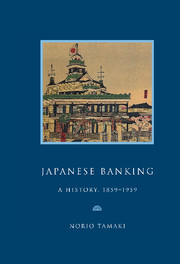Book contents
- Frontmatter
- Contents
- Preface
- Genealogy of leading Japanese banks, 1859–1959
- List of abbreviations
- Map
- Part I A bankrupt Shogunate, 1859–1868
- Part II The Meiji Restoration: monetary confusion and banking experiments, 1868–1881
- Part III Matsukata, the wizard of Japanese banking, 1881–1897; the Yokohama Specie Bank (1880) and the Bank of Japan (1882)
- Part IV The Japanese on the London money market, 1897–1911
- Part V War, the Japanese boom years, 1911–1919
- Part VI Crisis and the road to war, 1919–1937
- Part VII Complete commitment, struggle and defeat, 1937–1945
- Part VIII American ‘democratisation’ and the search for growth, 1945–1959
- Historical background
- 28 MacArthur's directives, 1945–1948
- 29 Remaking the banking system: the Japanese versus the Americans, 1946–1952
- 30 The rise of governmental banking and the search for stability: Japanese initiatives, 1949–1958
- 31 The post-war system, 1946–1959
- An extraordinary century, 1859–1959
- Appendices
- Notes
- Bibliography
- Index
30 - The rise of governmental banking and the search for stability: Japanese initiatives, 1949–1958
Published online by Cambridge University Press: 03 February 2010
- Frontmatter
- Contents
- Preface
- Genealogy of leading Japanese banks, 1859–1959
- List of abbreviations
- Map
- Part I A bankrupt Shogunate, 1859–1868
- Part II The Meiji Restoration: monetary confusion and banking experiments, 1868–1881
- Part III Matsukata, the wizard of Japanese banking, 1881–1897; the Yokohama Specie Bank (1880) and the Bank of Japan (1882)
- Part IV The Japanese on the London money market, 1897–1911
- Part V War, the Japanese boom years, 1911–1919
- Part VI Crisis and the road to war, 1919–1937
- Part VII Complete commitment, struggle and defeat, 1937–1945
- Part VIII American ‘democratisation’ and the search for growth, 1945–1959
- Historical background
- 28 MacArthur's directives, 1945–1948
- 29 Remaking the banking system: the Japanese versus the Americans, 1946–1952
- 30 The rise of governmental banking and the search for stability: Japanese initiatives, 1949–1958
- 31 The post-war system, 1946–1959
- An extraordinary century, 1859–1959
- Appendices
- Notes
- Bibliography
- Index
Summary
The Americans felt that the colonial banks and the Yokohama Specie Bank had been part of the Japanese war economy and they therefore insisted that they close down and that the Specie Bank convert itself into a small harmless Bank of Tokyo. The three remaining industrial banks, the Industrial Bank of Japan, Hypothec Bank and Hokkaido Development Bank, although still in existence, were vulnerable. SCAP first required the special banks to decide their own future by opting to become ordinary banks or debenture-issuing institutions. Two months later, in August 1948, SCAP issued a memorandum on ‘Overall Revision of Banking Structure’, which was designed to erase any traces of special banks reregistered themselves as ordinary banks, though the Industrial Bank did in fact soon discover a way to resume its old business. The prohibition of new advances by the Reconstruction Finance Cash Office, in addition to the suspension of special banking, was particularly unfortunate because demand for long-term borrowing strengthened as tension on the Korean peninsula was developing in early 1950. In these circumstances the government, with American consent, promulgated the Act of Issuing Bank Debentures in March 1950. The Industrial Bank was included. This heralded the start of the recovery. What was the government to do?
The government's approach to the problem was hesitant as, fearful of American disapproval, they laid down two moderate financial schemes to encourage the setting up of small businesses and consumer finance corporations. Small industries had been severely hit during the war and consumer goods were in very short supply. In any case the government only had the resources to remake smaller institutions.
- Type
- Chapter
- Information
- Japanese BankingA History, 1859–1959, pp. 198 - 201Publisher: Cambridge University PressPrint publication year: 1995



